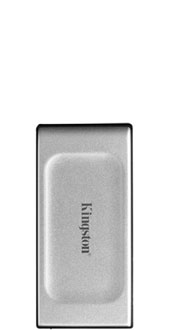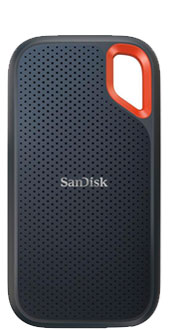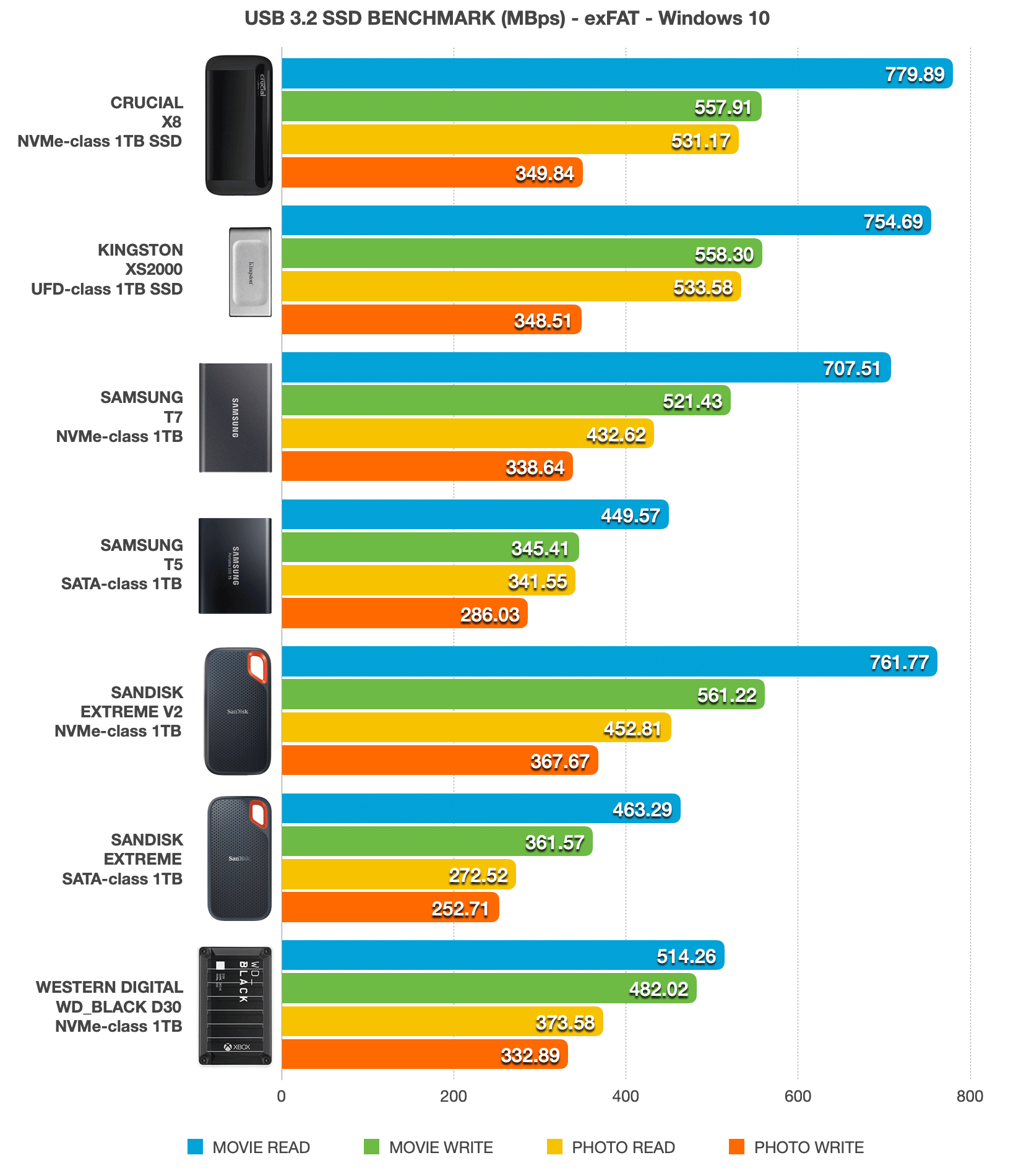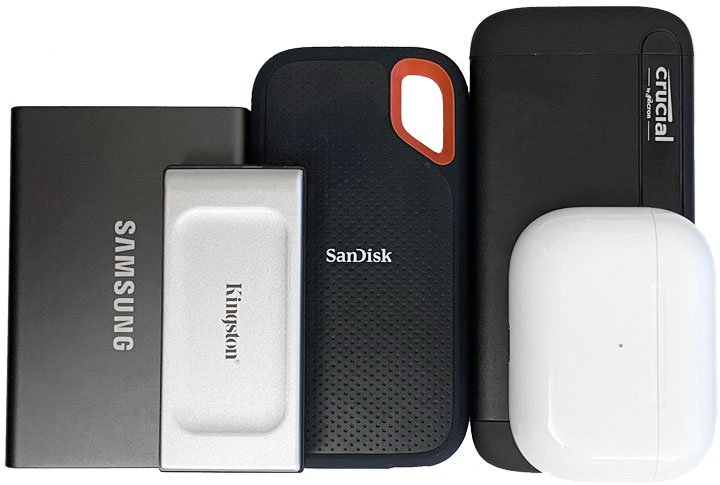
March 2025 Ian Chiu
External SSDs have rapidly overtaken HDDs as the preferred choice when it comes to mobile storage solutions for Macs and Windows PCs. Not only are they more durable compared to portable HDDs, but also competitively priced for their speeds and capacity. In this round-up, we have included five USB 3.2 SSDs from Crucial, Kingston, ORICO, Samsung, and Sandisk. These 1TB USB 3.2 SSDs offer universal compatibility with every Type-A and Type-C port. At the same time, they deliver a combination of stellar performance and affordability unrivaled even by high-end thumb drives.
Contents
Our Picks
Between these USB 3.2 SSDs, we have to pick Crucial X9 Pro for its exceptional performance consistency and its miniature size. The drive outperformed the rest of the pack in our stress test when other SSDs struggled once their respective SLC cache was saturated. The only caveat is the lack of software to enable the on-board hardware encryption. It does come with a generous five-year warranty.
If the lack of onboard security on the X9 Pro is a dealbreaker you, both the Samsung T7 and Sandisk Extreme V2 come with ready-to-use hardware encryption straight out of the box. It’s worth mentioning Kingston XS2000 is the most compact SSD of the pack and is capable of 20Gbps USB 3.2 Gen 2×2 connectivity, provided your USB-C port is compatible.
Current Trend
Industry-wide adoption of USB 3.2 Gen 2×1 (10Gbps) means SATA-class SSDs maxing out at 550MB/s can no longer catch up to USB. Since 2020, we’ve seen the inevitable shift to blazingly fast NVMe on mobile SSDs.
As for 2025, nearly all shipping USB SSDs are now either NVMe-based SSDs paired with a USB 3.2 Gen 2×1 to PCIe 3.0 x2 bridge chip or UFD-based SSDs with a direct NAND to USB 3.2 controller. Our real-world benchmark shows the latest batch of USB 3.2 SSDs can handle heavy lifting with speeds of 700 to 800MB/s yet the external interface remains a bottleneck for PCIe Gen 3 NVMe drives. Nonetheless, the performance leap is still impressive.
While USB 3.2 SSDs are predominantly Gen 2×1 (10Gbps), more come with a Gen 2×2 (20Gbps) interface. But unless you are building your own rig, those ports are hard to come by. You’re better off investing in a USB4 SSD if you are into future-proofing your equipment. In fact, it will be far easier to find a laptop with USB4 than one with USB 3.2 Gen 2×2 in a few years’ time since USB4 is already baked into Thunderbolt 4 and the latest AMD Ryzen powerhouse laptops also come with the latest variant of USB.
Feature Comparison
 Crucial X9 Pro SSD $97.00 for 1TB |  Kingston XS2000 SSD $92.99 for 1TB |  Orico C10 SSD $59.49 for 1TB |  Samsung SamsungT7 SSD $89.99 for 1TB |  Sandisk Extreme V2 SSD $99.99 for 1TB |
|
|---|---|---|---|---|---|
| Interface: | USB 3.2 Gen 2x1 (10Gbps) | USB 3.2 Gen 2x2 (20Gbps) | USB 3.2 Gen 2x1 (10Gbps) | USB 3.2 Gen 2x1 (10Gbps) | USB 3.2 Gen 2x1 (10Gbps) |
| Storage Options: | 1TB, 2TB & 4TB | 500GB, 1TB, 2TB & 4TB | 256GB, 512GB, 1TB & 2TB | 500GB, 1TB, 2TB & 4TB | 500GB, 1TB, 2TB, 4TB & 8TB |
| NAND Type: | Micron 176-layer TLC | Micron 96-layer TLC | To be confirmed | Samsung 92-layer TLC | WD 96-layer TLC |
| NAND Controller: | Silicon Motion SM2320 | Silicon Motion SM2320 | To be confirmed | Samsung Pablo | SanDisk 20-82-007011 |
| Bridge: | Silicon Motion SM2320 | Silicon Motion SM2320 | Realtek RTL9210 | ASMedia ASM2362 | ASMedia ASM2362 |
| Movie Read: (40GB MP4) | 773.26MB/s | 754.69MB/s | 797.07MB/s | 707.51MB/s | 761.77MB/s |
| Movie Write: (40GB MP4) | 573.10MB/s | 558.30MB/s | 610.58MB/s | 521.43MB/s | 561.22MB/s |
| Photo Read: (10GB JPEG) | 691.96MB/s | 533.58MB/s | 681.45MB/s | 432.62MB/s | 452.81MB/s |
| Photo Write: (10GB JPEG) | 337.29MB/s | 348.51MB/s | 339.38MB/s | 338.64MB/s | 367.67MB/s |
| Hardware Encryption? | 256-bit AES full-disk encryption | No | No | 256-bit AES full-disk encryption | 256-bit AES full-disk encryption |
| Software: | Encryption software still in the works | None | None | Samsung Portable SSD App (Android) | Sandisk Security SanDisk Memory Zone |
| Dimensions: | 65 x 50 x 10mm | 74 x 57.3 x 10.2mm | 132 x 34 x 12 mm | 85 x 57 x 8mm | 100.54 x 52.4 x 8.95mm |
| Weight: | 38g | 29g | 54g | 58g | 52g |
| Drop Protection? | Up to 2m | Up to 2m | Not specified | Up to 2m | Up to 2m |
| Environmental Resistance: | IP55 rating | IP55 rating | Not specified | IP55 rating | IP55 rating |
| Build Material: | Aluminum metal alloy with rubberized back | Aluminum metal alloy (Rubber sleeve included) | Aluminum metal alloy with plastic hanging hole | Aluminum metal | Plastic |
| Color(s): | Space gray | Silver | Silver | Indigo blue Titan gray Metallic red | Black with orange accent |
| Release Date: | July 2023 | Oct 2021 | July 2024 | Feb 2020 | Sept 2020 |
| Warranty: | 5 years | 5 years | 3 years | 3 years | 5 years |
Pricing is last updated by Amazon on 2025-04-09 at 11:12. When you buy through Amazon affiliate links on our site, we may earn an affiliate commission.
Sequential Benchmarks
For the intended purpose of external SSDs, our focus was on sequential read and write performance as most users will primarily use these drives for moving large files.
Benchmark tests were carried out on Nodesoft’s DiskBench to compare read and write speeds between different USB 3.2 SSDs on a 2018 15-inch MacBook Pro. The port being used supports Thunderbolt 3 with USB 3.2 Gen 2×1 (10Gbps) compatibility. Our test files comprised 40GB of MPEG-4 movies and 10GB of JPEG photos.
Two types of drives based on NVMe- and UFD-based SSDs were tested. Samsung T7, Sandisk Extreme V2 – the NVMe-based models – are based on ASMedia ASM2362 USB-to-PCIe x2 bridge with support for USB 3.2 Gen 2×1 (10Gbps). Kingston XS2000 and Crucial X9 Pro, in contrast, employ Silicon Motion SM2320 single-chip USB 3.2 Gen 2×2 solution that eliminates the need for a discrete bridge controller in order to reduce cost and size. Hence, said SSD is classified as UFD, short for USB Flash Drive.
It’s worth emphasizing Gen 2×2 (20Gbps) ports aren’t commonly found on PCs. So, you might not be able to enjoy the performance boost of an SSD that supports the dual-lane USB 3.2 mode unless your PC comes with such a port. Likewise, if your PC only provides Gen 1 (5Gbps), those ports would also become a bottleneck when paired with any NVMe-based Gen 2×1 (10Gbps) portable SSDs. Lastly, almost no one is selling external drives that are still based on SATA-based SSDs. We see no reasons to include last generation portable SSDs such as Samsung T5 and Sandisk Extreme V1 in the benchmark.

In terms of sequential read and write performance, all five external SSDs are fairly close. However, the Crucial X9 Pro, Kingston X2000, and ORICO C10 outperformed the Samsung T7 and SanDisk Extreme V2 by 7 to 17%, as the latter two are beginning to show their age. The difference is more profound in small file read operations, according to our benchmarks.
SLC Cache Stress Test
When it comes to flash storage devices, performance consistency is of paramount importance. These external SSDs only live up to their manufacturers’ claimed write speeds when files are written into the drives’ SLC cache. However, once the cache has been exhausted, incoming data goes directly into the native QLC or TLC area. For denser and slower NAND like QLC, this can wreak havoc on writing performance.
The size of the SLC cache varies from drive to drive. Even within the same model, larger capacity drives have proportionally larger allocations of cache than smaller ones. For that reason, it’s worth putting the SLC cache size and the post-cache write performance of these SSDs into comparison. For the purpose of this test, we copied a 400GB folder with an assortment of movie files ranging from 5 to 10GB to our 1TB SSDs. We continuously monitored for any irreversible trend of performance loss during the course of the transfers. The results are organized in the table below.
| Crucial X9 Pro SSD | Kingston XS2000 SSD | Orico C10 SSD | Samsung T7 SSD | Sandisk Extreme V2 SSD |
|
|---|---|---|---|---|---|
| SLC Cache Size: | Over 400GB | 96GB | 30GB | 40GB | 13GB |
| Post-cache Native Flash Write Speed: | To be determined | 300MB/s (during partial recovery) 60MB/s (lowest) | 300 to 360MB/s | 380 to 420MB/s | 560MB/s |
| SLC Cache Write Speed: | To be determined | 550MB/s | 610MB/s | 525MB/s | 580MB/s |
| Approximate Performance Loss (%) Beyond SLC Cache Limit: | To be determined | 54 to 89% | 40 to 51% | 20 to 28% | 3.5% |
Crucial X9 Pro 1TB has a very impressive direct-to-TLC write speed. We dumped a 400GB folder filled with an assortment of video files and we didn’t see any dips in performance. Incidentally, Crucial has a non-Pro version of X9 that features QLC NAND and a fair amount of SLC cache. Even so, you can expect a sizable drop in performance during prolonged write sessions.
Kingston XS2000 began at 550MB/s until post-cache write fell to 60MB/s after the 96GB mark. Its SLC cache did make partial recovery because write speeds started picking again and eventually hit 300MB/s. However, the drive fell into another cache cliff after what appeared to be another cache saturation. The cycle repeated itself until the completion of the transfer.
Samsung T7 1TB was able to maintain around 525MB/s up to the 40GB mark. After that, there’s a noticeable drop in write performance to between 380 and 420MB/s. Sandisk Extreme V2 held its own against the Crucial X9 Pro as the post-cache write speed was well within acceptable ranges. It has a relatively small SLC cache followed by a steady direct-to-TLC write throughout the transfer process.
Build & Durability
Every drive featured here is compact enough to fit easily into a pocket. ORICO C10 makes a very distinctive impression; on one end of the drive features a large hanging hole that hooks the C10 securely to lanyards, backpacks, or keychains. Its unique design does make the drive a lot longer though.
Crucial X9 Pro is now much sleeker and lighter, marking a substantial 40% size reduction over the previous X8 model. This is all thanks to new internal design that leverages the Silicon Motion SM2320 single-chip solution. The X9 Pro now shares a similar footprint with an Apple AirPod Pro case. In fact, it is the second most compact USB 3.2 SSD tested here, with the Kingston XS2000 being even smaller. The XS2000 measures just 70 × 33 × 13.5mm.

As far as durability goes, Kingston XS2000 comes with a very reassuring rubber sleeve that wraps around the drive for drop protection while Sandisk Extreme V2 has a silicone coating that provides impact and scratch resistance. Not only will they survive a 2m drop, but also likely hold up without a dent or scratch. Our only gripe with Extreme V2 is the use of flimsy plastic on the front panel, which is certainly a weak spot structurally.
In comparison, Samsung T7 with its aluminum unibody case feels very durable on hand. The SSD is tested for drops of up to 2m; however, dropping it onto a hard surface will surely leave a dent in the body. The drive could use a silicone case or bumper that helps to hold up to everyday wear and tear. Crucial X9 is enclosed in an anodized matte aluminum body with its back coated with a thin layer of rubber. Solid construction combined with shock absorbers ensures data survivability in case the drive is dropped (up to 2m) or stepped on.
SSDs in general are pretty resilient to drops but they are still vulnerable to splash and dust. Crucial X9, Kingston XS2000, Sandisk Extreme V2, and Samsung T7 are rated for IP55 so they have been tested for dust- and splash-proof – to a certain extent.
Best SSD Deals Online
| Preview | Product | Rating | Price | |
|---|---|---|---|---|

|
Crucial X9 1TB Portable SSD – Up to 1050MB/s Read, PC and Mac,... | No ratings yet |
$97.00 |
See it on Amazon |

|
Kingston XS2000 1TB High Performance Portable SSD with USB-C | Pocket-sized... | No ratings yet |
$115.99
$92.99 |
See it on Amazon |

|
ORICO 1TB External SSD Up to 1050MB/s, Hanging Hole Design Portable Solid... | No ratings yet |
$84.99
$59.49 |
See it on Amazon |

|
SAMSUNG T7 Portable SSD, 1TB External Solid State Drive, Speeds Up to... | No ratings yet |
$89.99 |
See it on Amazon |

|
SanDisk 1TB Extreme Portable SSD - Up to 1050MB/s, USB-C, USB 3.2 Gen 2,... | No ratings yet |
$129.99
$99.99 |
See it on Amazon |
Pricing is last updated by Amazon on 2025-04-09 at 11:12. When you buy through Amazon affiliate links on our site, we may earn an affiliate commission.
Nexcopy manufactures a variety of PC-based and standalone USB duplicator solutions.
PC based systems support advanced USB functions such as write protection, CD-ROM partition and multi-partition creation, while standalone systems are ultra-fast, high speed USB copiers duplicating gigabytes of data quickly and accurately.

